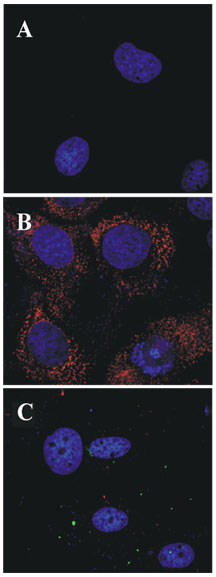RNA Interference Blocks Hepatitis C Virus Replication
By Jason Socrates
Bardi
In the less complicated times of the Gilded Age 100 years
ago, aspiring debutantes had simply to have themselves announced
as they entered a room to make a splash in society. Today,
they have to hope for an appearance in the Sunday Styles
section of the New York Times to announce that they
have arrived.
On Tuesdays, technologies, like debutantes, face the eyes
of the public on the pages of the New York Times. Whatever
technology, molecule, or theory appears in the Science
Times section has truly arrived.
Last month, RNA interference was featured in a Science
Times article describing how a team of scientists had
used the technique to selectively knock out genes of a worm.
Now a recent study by Professor Frank Chisari and Research
Associates Sharookh Kapadia and Amy Brideau-Andersen in the
Department of Molecular and Experimental Medicine has applied
the technique of RNA interference to knock out genes in a
different organism—the hepatitis C virus (HCV). HCV is
a major cause of chronic liver disease in the United States
and currently infects some 3.9 million Americans, estimates
the Centers for Disease Control (CDC), and over 180 million
people worldwide.
A couple of years ago, Chisari heard a lecture by Phillip
Sharp, a Nobel laureate and a professor of biology at the
Massachusetts Institute of Technology, describing RNA interference
(RNAi), a natural antiviral mechanism of plants that had also
been used to inhibit gene expression in worms and fruit flies.
In his lecture, Sharp described the use of RNA interference
to shut down cellular gene expression in mammalian cells.
Chisari immediately recognized that RNAi should also be
able to shut off viral gene expression in human cells, and
last week, in an article published online by the Proceedings
of the National Academy of Sciences, Chisari, Brideau-Andersen
and Kapadia report that RNA interference can inhibit HCV replication
in tissue culture. Others have shown that RNAi can inhibit
HIV, poliovirus and rotavirus replication as well.
The technique involves delivering small, 20- to 30-base
pieces of double stranded RNA into a cell. Once inside the
cell, these short sequences anneal to complementary regions
of cellular or viral RNA and trigger an intracellular response
that specifically destroys the target RNA. If the RNA is viral
in origin, this response can silence the target gene and prevent
viral replication.
Though the technique is in its infancy, and many technical
barriers must be overcome before any drug based on RNA interference
reaches the pharmacist's shelf, it does hold great promise
for the treatment of HCV and other infections, says Chisari.
The technique is of immediate interest in basic science because
it can be used to selectively shut off normal cellular genes
in a developing or a mature organism, permitting scientists
to study the impact of the absence of the corresponding gene
products on cellular function and tissue development.
To read the article, "Interference of hepatitis C virus
RNA replication by short interfering RNAs" by Sharookh B.
Kapadia, Amy Brideau-Andersen, and Francis V. Chisari, please
see:
http://www.pnas.org/cgi/content/abstract/252783999v1.

|

The top panel shows parental cells stained
in blue. The middle panel shows cells infected with hepatitis
C virus (HCV) cells and the baseline level of HCV replication,
in red. The bottom panel shows the greatly reduced level of
HCV replication four days after the cells were transfected
with the HCV-specific short interfering RNAs, shown in green.
Click to enlarge.
|

